We got acquainted with the basic computer terms and definitions. We practically studied the purpose of all (almost) keys on the keyboard using examples. Only a number of function keys remained uncovered F1, F2,..., F11, F12. And, although I have already mentioned two keys, it is best to consider their purpose in specific programs. Since in different programs These keys are often “hardwired” with different functions.
Therefore, while considering the appointment various programs, we will simultaneously consider the purpose of the function keys.
One of the most used types of programs are text editors or, as they are sometimes called, word processing programs.
Other name text editors — word processors. This name was inherited from the 70s of the last century. At that time there were no “powerful” text editors and graphics.
But there were special machines that combined the capabilities of entering text from a keyboard, displaying the entered text on the display, a built-in computer for the simplest, as well as a printing device. These devices were called word processors.
By the way, as I already wrote in the lesson “”, the key « Print Screen» then performed the function of sending the screen contents for printing. Now, in almost all editors, a key combination is used to send screen contents for printing "Ctrl+P": + .
With development computer technology, appeared computer programs- text editors that perform similar functions. These programs inherited the name “Word Processor”.
With the names, I think it’s clear. Now let's see what they are.
There are actually a lot of text editors and their varieties. To the point that when you write a letter to someone or leave comments, you use the built-in text editor module in your email, blog or forum.
So why are there so many of these editors, how do they differ, and which one is best to use?
Let's look at a few editors to answer these questions.
Likewise the menu item "Edit". 1st group - canceling the last action. 2nd group - cut, copy, paste, delete text. 3rd group: text search and text replacement (this will be a separate lesson). 4th group - this is the selection of all text, and an interesting menu item "Time and Date".
As we can see from the drop-down menus, Notepad uses two function keys. More precisely three.
Key F5 is used as a hot key and serves to insert the current time and date set on your computer into the text.
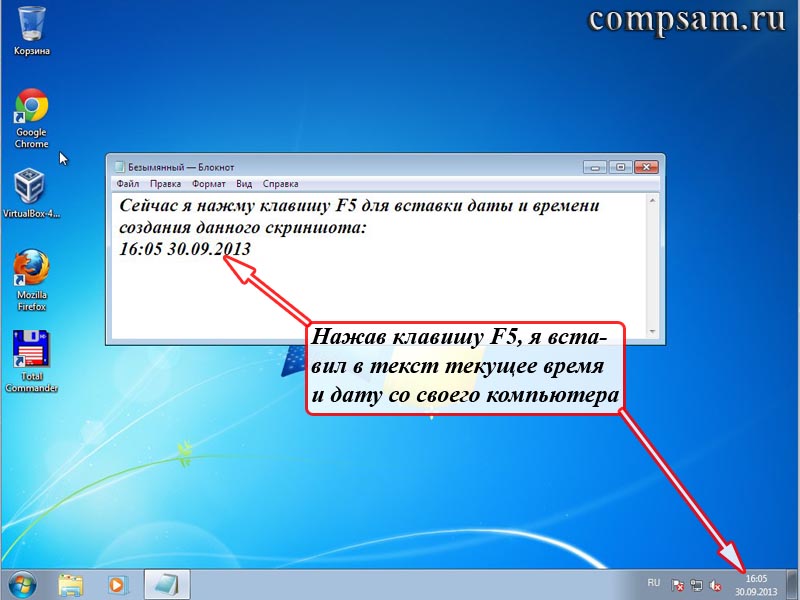
Key F3 used to continue searching for text (as I said, this will be a separate lesson).
Well, the key F1, which is no longer even mentioned, calls up help for the program you are currently using. In our case - help using the Notepad program.
Also note that almost all items in the drop-down menus can be performed not with the mouse, but with hot keys.
The exception is least used menu items “Save as...”, “Page settings...”, “Exit” (successfully replaced by a red cross), “Word wrap”, “Font...”, “Status bar”, “Call help " and "About the program".
Typically menu items "File" And "Edit" quite enough to work in any text editor.
Another important point! Menu item "About the program" available in any program. Here you can see the manufacturer of this software and, very importantly, program version.
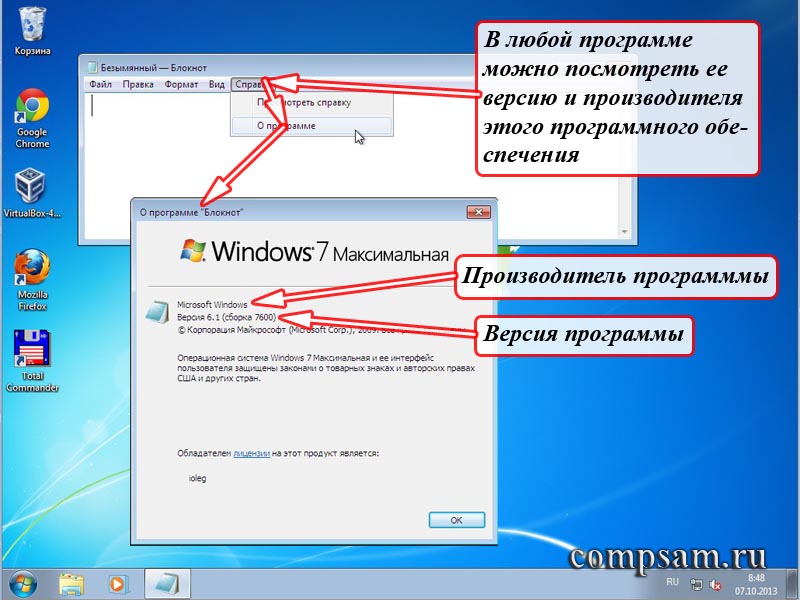
The Notepad editor is quite simple and lightweight. “Lightweight” means that it takes very little resources from the computer when running. Moreover, files in the format in which it default saves files ( .txt), very small in size.
Actually, that’s where the advantages end. It is impossible to insert any pictures, tables, or objects here. Text only.
Whether or not to use this editor for your work is up to you.
For my part, I will say that I use this editor to save texts of jokes, recipes, wise thoughts of great people, my logins and passwords (which does not exclude). Saving is convenient, but editing... not so much. An example would be a lesson. Such tricks will not work in the Notepad editor.
Similar simple editor programs are available on the Internet. So called text online editors. An example of one such editor is shown in the screenshot. Internet address https://note-pad.net
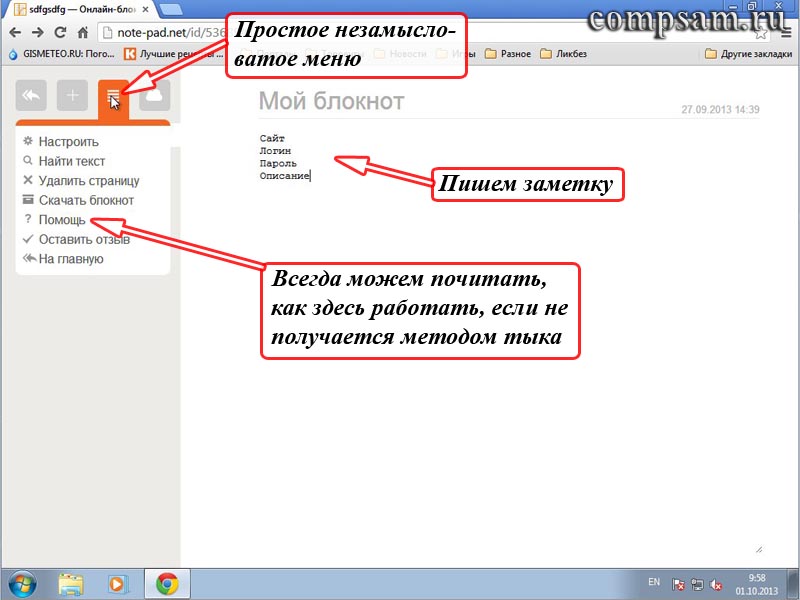
Quite convenient if you don't have it on hand notebook with a handle. At any time, you can download the information entered there and then simply delete it.
You can work with or without registration. If there is no registration, then after closing the browser the information will be lost.
Well, if there is registration, then the data is saved. Moreover, you can “link” this little diary in the cloud to your email so that you always have it at hand. But this is also a separate topic.
WordPad
Another text editor that is installed on your computer by default is the WordPad text editor (Wordpad). By default, it is called in the same way as the Notepad program.
True, there is a noticeable difference in this program for Windows users XP and Windows 7. In these operating systems installed by default different versions this editor, although the principle of operation in them is absolutely the same.
WordPad (version 5.1) included with Windows XP

As you can see, the menu is approximately the same. The “View” menu item has just been added, which adds or removes toolbars with icons. Moreover, these panels can be removed or added by clicking on the corresponding item in the drop-down menu with the left mouse button.
The principle of operation in this editor is the same as in Notepad. But the functionality is a little richer.
Here we can already create a document similar to the statement from the lesson “Editing and Formatting”.
Interesting point. There is no hotkey F5 to insert date and time. But now there is a choice in what format you want to see the date and time in your text.

WordPad (version 6.1) included with Windows 7
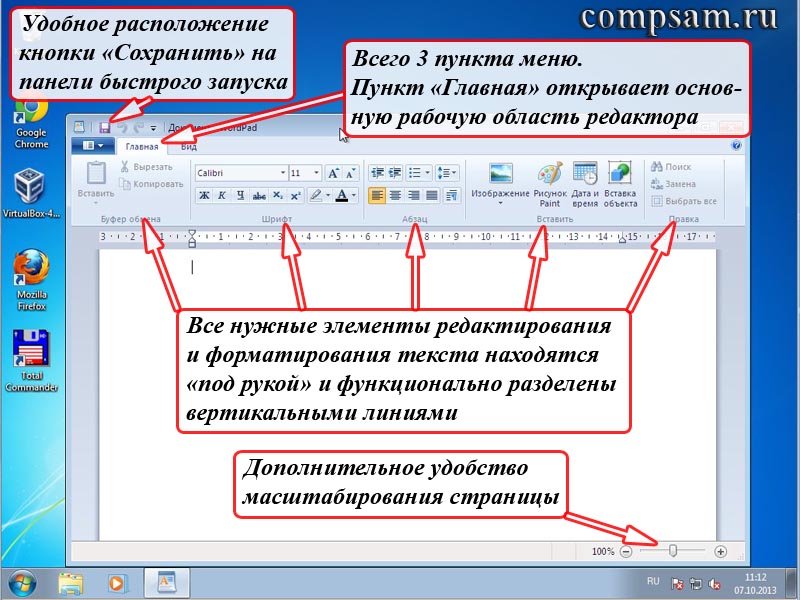
In the redesigned interface, the developers (programmers and designers) tried to arrange all the elements more compactly and more convenient for the user. Whether they succeeded or not, decide for yourself.
For example, it was difficult for me to adapt. For 20 years I have gotten used to classic interfaces. But there is nowhere to go, you have to master it. And, if with WordPad everything is more or less simple, then I “got used to” the programs from the professional office suite from Microsoft for about a month.
But, on the other hand, after working for a couple of weeks, I found many advantages and conveniences in the new interfaces.
What more can be said about this version of WordPad.
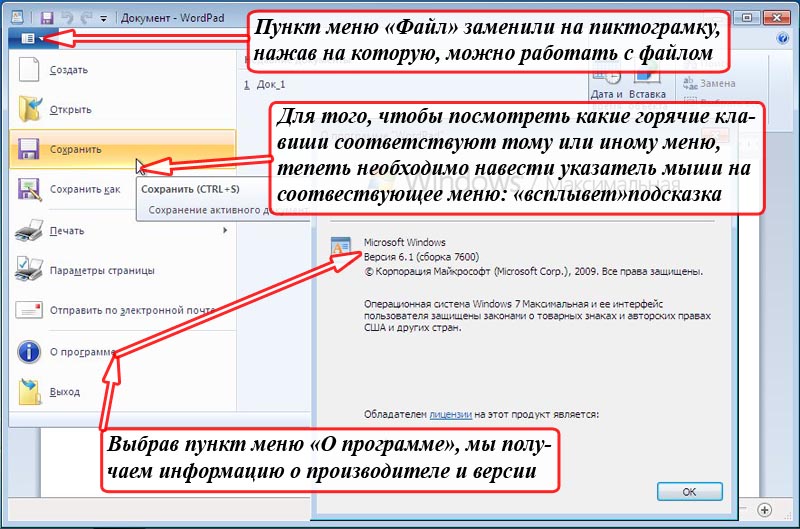
The classic “File” menu item has been replaced with an icon, clicking on which opens a standard submenu for working with the file. Here we can see information about the manufacturer and version of the program.
Well, in order to find out whether there are corresponding hot keys for executing a menu item, you need to hover the mouse pointer over this menu item. IN in this example I hovered my mouse over the “Save” inscription. I got a hint for corresponding hotkeys "Ctrl+S".
Another important point!
Default WordPad saves files in the format RTF (.rtf), which can be opened and edited in the Word text editor from the same Microsoft. But you can no longer open and edit in Notepad.

But I want to draw your attention to another format in which you can save the contents of the file. This open office document format - OpenDocument Format, ODF (open document format). What does open mean?
A little history
As I said, as soon as computers appeared, text editing programs immediately appeared.
Software manufacturers began to create word processors and come up with formats in which documents could be saved and stored.
These editors entered the market with different prices, functionality, etc.
Each development company jealously kept the secrets of the specifications of its formats from the eyes of competitors. The market is the market.
The most interesting thing is that documents made in one editor could not be opened in another editor. Since the specifications were not published anywhere for public viewing, but were kept secret, they were closed.
Time flew by. Editors and formats multiplied until problems began.
Imagine that you work for a large corporation. Your corporation has purchased a professional word processor for its employees.
As time went. Millions of documents were created. And suddenly the company from which the program was purchased went bankrupt. All. The purchased program is no longer supported.
More time passes. Computers are advancing, new operating systems are being created. And, at one fine moment, the program suddenly does not install on a new computer under a new operating system.
And the new editors do not support the format in which the corporation has produced documents. The situation, of course, is not a stalemate. But how much time, nerves and money will it take to translate documents into new formats?
What if the format into which you are translating your documents ceases to be supported in a year or two along with the new editor you purchase?
And what, so in a circle?
The world community looked at this nightmare, or rather felt it the hard way, and came to the conclusion that this situation needs to be fixed. And as quickly as possible.
The result of many years of work was a standard that was developed by the industrial community OASIS .
Then, all software manufacturers, including text editors, were recommended to include in their programs the ability to save documents in open formats.
Thus, support for open formats in the WordPad editor appeared with the release of the operating system Windows systems 7. And in office programs, starting with the office suite Microsoft Office 2007.
Thus, if the file is saved in open format, then in the future it will be possible to open it with any editor under any .
Professional text editors
Professional text editors are usually included in special office packages. These packages include a set of programs needed in production.
The range of tools in the programs from these packages is simply huge. The features and amenities are simply impressive.
You've probably all heard of such an office suite as Microsoft Office (Microsoft Office), which includes application programs: Word (Word - text editor), Excel (Excel - spreadsheets), Access (access - databases) , Outlook (outlook client Email, which we already talked about in the lesson “Client and Web Interface”), etc.
We will briefly look at all applications, but not within the scope of this lesson.
Software package (applications) Microsoft Office is paid. Now I specifically looked at the prices on the Internet.
For example, the latest office suite from Microsoft “Office Professional 2013” for installation on one computer costs 19,559 rubles (when I looked at the price, the chewing gum fell out of my mouth).
In this article I want to mention only one program from this package - a text editor Microsoft Office Word.
As in the case of WordPad, starting with Microsoft Office 2007, the interface of programs from this package has changed.
If Word is from Microsoft package Office 2003 still had the old standard interface,

then in Word from the Microsoft Office 2007 package it is already updated.
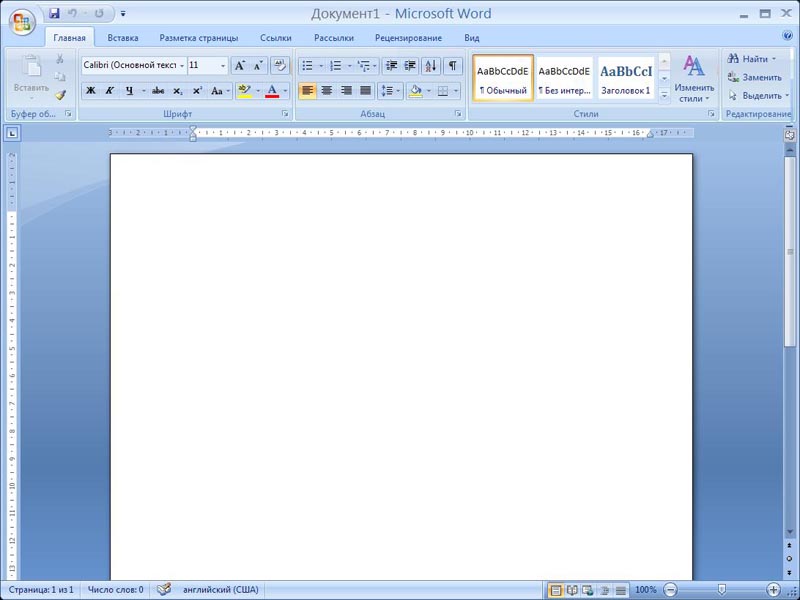
By the way, a classic example from our excursion into history. "Office Professional 2013" will only work on Windows 7 and Windows 8 operating systems. But on Windows XP and Windows Vista, the programs from the package can no longer be installed. So-called, incompatibility.
Plus, support for applications from the Microsoft Office 2003 suite, which is “ideal” for Windows XP, is ending.
But that's not all.
By default, Word from Microsoft Office 2003 saves files in DOC (.doc) format, and Word from Microsoft Office 2007 saves files in DOCX format(.docx), which are partially incompatible with each other.
And, although this problem can be solved, a bad trend can still be traced.
But not everything is so bad and sad. And it is not at all necessary to install broken or stolen Microsoft Office on your computer.
An alternative to a paid office software package is free (free) office packages OpenOffice.org (open office org) and LibreOffice(Laybre office).
In terms of functionality, free office suites are almost in no way inferior to the package from Microsoft Office.
The application interfaces in OpenOffice.org and LibreOffice are almost the same.
Default programs from packages save files directly to open formats.
Text editor interface Writer(raite):

As can be seen from the figure, the program interface is closer to the classic look, in contrast to the updated interfaces from Microsoft.
As I already said, there are quite a lot of tools in the programs of these packages. Here is an example for the Word editor from Microsoft Office 2003

Is it possible to learn the purpose of everyone? available tools? I don't know. I didn't even try it. Two toolbars, “Standard” and “Formatting,” which are enabled by default, were enough for me to work.
I actually studied the purpose of the editing tools in these panels. Where at random, where by calling up help for the program using a key F1. Well, I partially watched the lessons on the Internet, fortunately they are now “like dirt.”
Text editors are programs for creating and editing text documents. These are letters, articles, certificates, stories or novels and other information called a text document, text file or simply text.
Under text editing understands the whole complex of operations on internal (semantic) and external (design) work on the text. Each text can be “cut”, i.e., cut out pieces from it, “glued” them together, insert parts from other texts into the working material, swap them, etc. You can change the location of the text on the page, the format of lines and paragraphs, insert into illustration text (drawings, graphs, diagrams, etc.).
When describing word processors, two groups should be distinguished software products this type. The first group is focused on creating documents of varying degrees of complexity with powerful formatting tools and the inclusion of graphics. A typical representative of this group is Microsoft Word. The second group of word processors (they are often called text editors) is focused on working with purely text files, which may include program texts written in various languages, configuration files, settings files, etc.
A prominent representative of such software products is MultiEdit. This word processor has powerful system contextual replacement, built-in macro language at the Visual Basic level, internal environment support tools, help tools for typing keywords.
There is another separate group word processors are desktop publishing systems. Publishing programs (Desktop Publishing) are somewhat similar to conventional word processors, but differ from them in a wider range of capabilities for working with text. Publishing systems include products such as Adobe PageMaker, Adobe In Design, Quark X Press. However, it should be noted that this difference is gradually disappearing, and editors such as Word Perfect or Microsoft Word are already approaching publishing programs. In any case, they are able to provide typing and printing of simple publications.
Typically text editors include the following features:
- - typing;
- - correction of typed text in the usual way, i.e. changing letters, words, etc.;
- - cutting out fragments of text, memorizing them throughout current session works, as well as in the form of separate files;
- - inserting fragments into the desired place in the text;
- - finding the necessary words or sentences in the text;
- - replacing words one with another partially or completely throughout the text;
- - formatting the text, i.e. giving it a certain appearance to the following parameters: the width of the text column, paragraph, margins on both sides, top and bottom margins, distance between lines, alignment of the edges of lines;
- - automatic division of text into pages with a specified number of lines;
- - automatic page numbering;
- - automatic entry of subheadings at the bottom or top of the page;
- - highlighting part of the text in bold, italic or underlined font;
- - switching the program to work with a different alphabet;
- - tabulation of lines, i.e. creation of constant intervals to represent text in the form of columns;
- - printing the text or its individual pieces;
The most advanced editors also have additional features, such as:
- - the ability to see the text in finished form on the screen, i.e. the way it will be printed by the printer;
- - wide selection of fonts;
- - insertion of formulas, tables, figures into the text;
- - creating several text columns on one page;
- - automatic search and correction of grammatical errors;
- - selection of ready-made styles and templates.
An integral part of computer operation is a text editor. This is a program that allows you to type text, edit it, and also visually design it. In this article, the site’s journalists will review the most popular text editors, talking about their functions, advantages and disadvantages.
What types of text editors are there?
We decided to place our list of text editors in order of functionality and popularity. We will look at text editors for both the Windows and Linux operating systems. Well, let's get started with the review.
This is the simplest and most straightforward text editor in Windows. This text editor is used for any notes, small phrases and other notes. Many programmers copy into notepad various codes, which in Notepad remain in their original form, since more advanced text editors can recognize them and transform them visually, ultimately losing part of the code. It is also convenient to copy passwords, links, and console commands into Notepad. Notepad comes along with the standard pre-installed operating system software package; in fact, it is free.
The Linux operating system has its own analogue of notepad - gedit. The program is absolutely identical in function and purpose to its Windows counterpart.
The advantage of these text editors is that they are simple and compact, ideal for marking up and storing code elements. Disadvantage this editor The advantage of the text is its redundant prostate, which does not make it possible to complete the test.

For more advanced computer users The best option is the extended version of the notepad - Notepad++, which has a large number of functions, but at the same time remains the same notepad. You can download the notepad from the official website of the program Notepad-plus-plus.org. The program has a Russian interface and is distributed free of charge.

WordPad is another standard text editor that comes pre-installed in Windows programs. Looking ahead, in order to more accurately describe this program, it is worth saying that WordPad is something between Notepad and Microsoft Word. That is, WordPad has a simple base, like Notepad, but it includes some text design elements from Word. This combination: simplicity + minimum set design features make it quite attractive to set plain text, which does not require special design. WordPad is an ideal option for those who need to type simple text documents By using this program, you can save on the purchase of Microsoft Word, just keep in mind that the program checks spelling very poorly.

Initially, this office suite was created for the operating room Linux systems, replacing the established OpenOfficeOrg at that time, which still exists today. A Windows version of LibreOffice was then released.
To briefly describe this office suite, it is Word 2003 with not very good spell checking quality. But at the same time, what could you want from a free text editor? For everyday needs in Windows and Linux, in order to save beautifully framed text on your computer and print it, this is the best option, since you do not need to spend extra money on purchasing an office suite from Microsoft. You can download the office suite for Windows from the LibereOffice page. As mentioned earlier, it is installed by default on Linux.

Microsoft Word. Finally, we moved on to the flagship of text editors - Word. This application It is not without reason that it is a flagship, since even to this day it has no analogues that could implement a beautiful and user-friendly interface, with a large number of functions, for editing and designing texts. It is rightfully considered the best text editor in Windows 7 and Windows 8. Word is an indispensable text editor for any user who needs to frequently type texts and documents. In addition, it is worth noting good quality spell checking in texts, which no other text editor for a computer can boast of. The only drawback of Word is its price, since for the most budget office suite you will need to pay about 3,000 rubles, which is quite expensive. However, if you often encounter the need to type, then you have virtually no choice but to purchase an office suite from Microsoft.

Online text editor. And finally, we’ll tell you about modern form text editors – about online text editors. This type of text editor allows you to type text directly on a remote server on the Internet - online. The advantages are obvious - the typed text is immediately saved in cloud storage and therefore, access to the text can be opened to several users at once (and even edited together), and you can also have access to these documents from all your devices that are connected to the Internet. Thanks to this, you are not afraid of data loss or power outage - the document is always available on the Internet.
The best online editor text is the Google Drive service. By registering yourself cloud drive, you can create text documents on it. The design, of course, of such documents does not shine with special beauty, but it is of no particular use here, since it is an extra load on the Internet channel, and the main thing is typing. Spell checking is done by the browser, which is certainly not an ideal option, but not the worst either. The advantages include the free service, which is important. The document can be immediately saved on your computer if necessary.
This concludes our review. We hope that our article will help you decide on the choice of a text editor.
What is a text editor? - section Computers, Computer Software Text Editor - This is a Program Used by...
End of work -
This topic belongs to the section:
Computer software
How is it classified? software.. to a first approximation, all programs running on a computer can be conditionally..
If you need additional material on this topic, or you did not find what you were looking for, we recommend using the search in our database of works:
What will we do with the received material:
If this material was useful to you, you can save it to your page on social networks:
| Tweet |
All topics in this section:
What is software?
Software is understood as a set of programs executed by a computer system. To the software
System programs run together with application programs and serve to manage computer resources - central processor, memory, input-output
These are general use programs that are intended for all users of the computer. System software is designed so that the computer can efficiently run
What is an operating system?
An operating system is a complex of interconnected system programs, the purpose of which is to organize the user’s interaction with the computer and the execution of all other
What is an OS file system?
A file (English file - folder) is a named collection of any data located on an external storage device and stored, sent and processed as e
What is the structure of the MS DOS operating system?
Operating system MS DOS (Microsoft Disk Operating System) is the most common operating system on 16-bit personal computers. It consists of the following main modules (Fig. 6.4):
What are shell programs?
Shells are programs designed to make working with complex software systems, such as DOS. They transform the inconvenient command user
Windows operating systems
Currently, most computers in the world run one or another version of the operating system. Windows environment Microsoft company. Characterize
Unix operating system
The Unix operating system was created at Bell Telephone Laboratories. WITH a short history its creation can be found here. Unix - a lot
Linux operating system
The creation of the Linux system began in 1991 by Finnish student Linus Torvalds. In September 1991 he distributed
What is a translator, compiler, interpreter?
Translator (English translator - translator) is a translator program. It converts a program written in one of the languages high level, into the program, consisting
What are programming systems?
A programming system is a system for developing new programs in a specific programming language. Modern systems programming about
What are tool programs needed for?
Instrumental software- these are programs that are used during the development, adjustment or development of other application or system programs.
What is a graphics editor?
Graphics editor is a program designed to automate the processes of constructing graphic images on the display screen. Provides drawing capabilities
What are the capabilities of business and scientific graphics systems?
Pie and Bar Charts Systems business graphics give
What is a table processor?
A spreadsheet processor is a set of interconnected programs designed for processing spreadsheets. A spreadsheet is the computer equivalent
What are database management systems?
A database is one or more data files designed to store, modify and process large volumes of interrelated information.
What are standard routine libraries?
A library of standard routines is a collection of routines written in one of the programming languages and satisfying certain uniform requirements for page
What are application packages?
Packages application programs(PPP) are specially organized software systems designed for general use in a certain problem area and additional
What are integrated software packages?
Integrated packages are a set of several software products combined into a single convenient tool. The most developed of them include text
What are organizers?
Organizers are programs - electronic secretaries.
What is network software?
Network software is designed to organize collaboration of a group of users on different computers. Allows you to organize a common file structure
While working at a computer, we are extremely often faced with the need to create, edit, design and print text information. For this purpose they are used special programs. Let's try to figure out what it is and why it is needed.
Definition
Text editors are specialized programs that allow you to create, format, edit, save and In addition to the text itself, modern documents can contain other objects (tables, lists, diagrams, images, etc.).
The most popular programs for working with text
Now that you already know what a text editor is, we can talk about which applications in this category are the most popular.
Microsoft Word
Probably the most widespread and easy-to-use program. Lots of settings, options, extensive functionality, support for collaboration and reviewing.
Open Office
Free alternative to MS Office software package. The Open Office text editor is slightly inferior to Word in terms of functionality and is not as attractive modern interface, however, overall it’s quite good for performing basic tasks.
AbiWord
Supports quite a few different text formats, including doc and rtf. Weighs this program very small, works fast enough, does not freeze and meets all the requirements of a modern user.
GNU Emacs
Multifunctional free editor, adapted to work on different operating systems. The basis of the Emacs ideology is the principles of extensibility, customization to user requirements and the desire to combine “all in one”.
However, be that as it may, the good old Microsoft Word is considered the most popular, reliable and convenient.
Main features of MS Word
What is it and what functions can it perform? A unique program created by Microsoft specialists has been improved over several decades. Modern MS Word allows you to:
- enter and edit text using the keyboard with the ability to subsequently save it in the computer’s memory;
- format information (change parameters and text formatting);
- use tools for previewing documents in the process of preparing them for printing;
- process multiple documents simultaneously;
- check spelling, spelling and punctuation in different languages;
- embed into text graphic images and diagrams;
- create and add tables to the text, edit them;
- use macros in documents, etc.
As for the disadvantages of MS Word, there are not so many of them. However, speaking about what a text editor is, it is worth saying that not all of them are suitable for certain purposes. For example, in the case of Word, you may have problems entering chemical formulas and complex mathematical expressions. In addition, this text editor is not intended for the production of complex printed products (magazine atlases, etc.) or for editing high-quality images.

Studying the MS Word word processor menu
Knowing what a text editor is, you will, of course, want to know more about its capabilities. You can get a general idea of the functionality of MS Word by familiarizing yourself with the main command tabs of the program:
- Home. Contains a set of commands related to setting paragraphs, styles and choosing fonts.
- Insert. Allows you to embed pages, tables, links, illustrations, footers, headings, symbols and text objects into a document.
- Page layout. Here you can find commands for working with topics, paragraph spacing, background images. On the same tab there are tools that allow you to configure the page parameters and the order of elements on it.
- Links. The commands on this tab will be useful to those who already know what a text editor is and are working on creating serious voluminous works (table of contents, bibliographies and citations, index, headings, footnotes, etc.).
- Newsletters. Here are all the features you need to create, preview, and send mail.
- Reviewing. Tools for checking documents (thesaurus, spelling, etc.). On the same tab, you will see commands that allow you to share the document with other users for review, add a comment, track and process changes, compare versions, and protect the document.
- View. This tab is responsible for viewing a document in different modes and the ability to view multiple documents.

In the upper left corner you can find the "File" button, which opens the main menu of MS Word, the commands of which allow you to open, save, print documents, and also learn more about installed version programs about what text is Microsoft editor Word and go to detailed help. In addition, in the "File" menu you can change the default settings of the program itself (spelling settings, autosave, theme, etc.).
Essentially, now you know a text editor, and you can easily find the commands you need to work.





